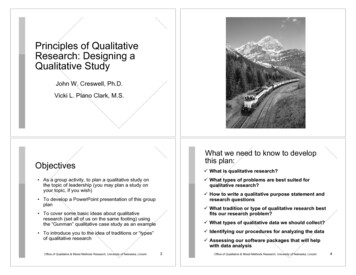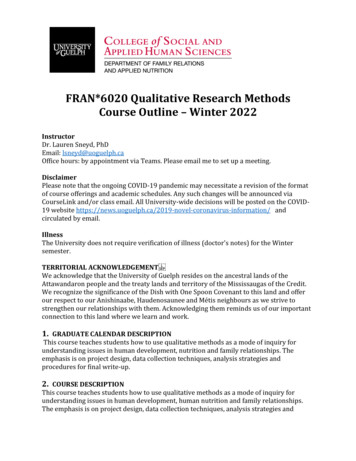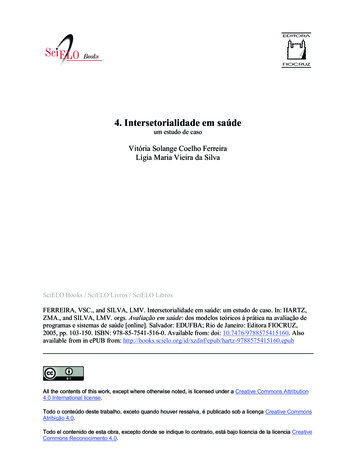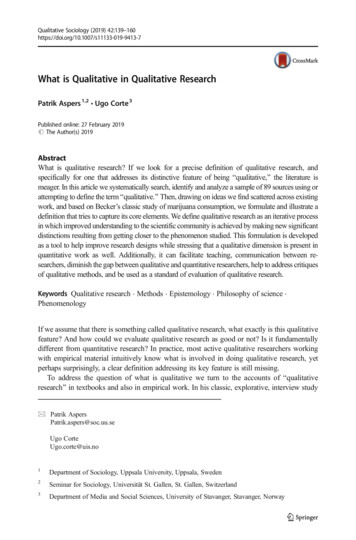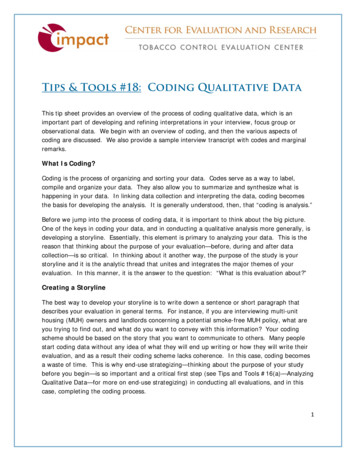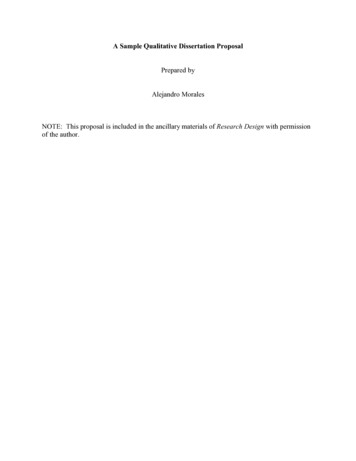
Transcription
ArticleThe qualitative research proposalH Klopper, PhD; MBAProfessor, School of Nursing Science, North-West University (Potchefstroom Campus), South AfricaKey w ords: Proposal, QualitativeR esearch, A ttributes, Q ualitativeProcessAbstract: Curationis 31(4): 62-72Qualitative research in the health sciences has had to overcome many prejudices anda number of misunderstandings, but today qualitative research is as acceptable asquantitative research designs and is widely funded and published. Writing theproposal of a qualitative study, however, can be a challenging feat, due to the emergentnature o f the qualitative research design and the description of the methodology asa process. Even today, many sub-standard proposals at post-graduate evaluationcommittees and application proposals to be considered for funding are still seen.This problem has led the researcher to develop a framework to guide the qualitativeresearcher in writing the proposal of a qualitative study based on the followingresearch questions: (i) What is the process of writing a qualitative research proposal?and (ii) What does the structure and layout of a qualitative proposal look like? Thepurpose of this article is to discuss the process of writing the qualitative researchproposal, as well as describe the structure and layout of a qualitative research proposal.The process of writing a qualitative research proposal is discussed with regards tothe most important questions that need to be answered in your research proposalwith consideration of the guidelines of being practical, being persuasive, makingbroader links, aiming for crystal clarity and planning before you write. While thestructure of the qualitative research proposal is discussed with regards to the keysections of the proposal, namely the cover page, abstract, introduction, review of theliterature, research problem and research questions, research purpose and objectives,research paradigm, research design, research method, ethical considerations,dissemination plan, budget and appendices.Background andintroductionCorrespondence address:Prof HC KlopperSchool of Nursing ScienceNorth-West UniversityTel: (018) 299 1829/1830Fax:(018)2991827Email: Hester.Klopper@nwu.ac.zaM orse (2003:833) points out thatqualitative methodology is used whenlittle is known about a topic, theresearch context is poorly understood,the boundaries of a domain are illdefined, the phenom enon underinvestigation is not quantifiable, thenature o f the problem is not clear, orthe re searc h er suspects that thephenomenon needs to be re-examined.Researchers need a clear picture of theissues and questions that they want toinvestigate, as well as ideas o f howthey are going to go about investigatingthem, but always with an openness ofmind to improvise, revise and adjust.Writing a proposal for a qualitative62Curationis December 2008study is therefore a challenge, as thequalitative researcher “designs studiesby conducting them - as opposed toconducting studies by d esig n ”(Sandelowski & Barroso, 2003:781).Q uantitative researchers generallybelieve they know what they do notknow (i.e. know ing the type o fknowledge they expect to obtain bydoing a study and then striving toobtain it). A qualitative researcher, bycontrast, enters the study “ notknowing what is known” (i.e. notknowing the phenomenon that willdrive the inquiry forward) (Loiselle,Profetto-M cG rath, Polit & Beck,2004:208). The qualitative proposalwriter can therefore only anticipate howthe study will proceed. Qualitativeresearch begins by accepting that there
is a range o f different ways of makingsense of the world (that the truth is onlyvalid in a specific context) and isco n cern ed w ith d isco v erin g themeanings seen by those who are beingresearched and with understandingtheir view of the world rather than thatof the researcher (Jones, 1995:2)Problem statementQ ualitative research in the healthscien ces has had to overcom ep reju d ice and a num ber o fm isunderstandings. Some o f themisunderstandings include the beliefsthat qualitative research is “easy”; andthe “stigm a o f the small sam ple” .H ow ever, by now we know thatqualitative research experts make thesem isin terp retatio n s redundant andirrelevant as more and more qualitativestudies are funded, and results arepublished widely. Notwithstanding thefact that qualitative research is now asacceptable as quantitative researchdesigns, sub-standard proposals atpost-graduate evaluation committees orapplication proposals to be consideredfor funding are still seen. Writing theproposal o f a qualitative study ischallenging due to the emergent natureof the qualitative research design andthe description of the methodology asa process. In response to the nature ofhealth care practices that focus onpatient care, there is an increasedtendency to investigate phenomenafrom a q u alitativ e p erspective.Therefore the following questions canbe asked: (i) What is the process ofwriting a qualitative research proposal?and (ii) What does the structure andlayout o f a qualitative proposal looklike?PurposeThe purpose of this article is twofold,i.e. the process of writing the qualitativeresearch proposal will be discussed,follow ed by a d escrip tion o f thestructure o f a qualitative researchproposal, including examples fromqualitative studies (where relevant).Process of the qualitativeproposalQ ualitative researchers often findthemselves in a “catch-22” situation.They have intentionally selected aqualitative research design, as little isknown about the phenomenon to bestudied; yet it is expected to write howdata analysis will be done when the datais not known. However, it is imperativethat the researcher must convince theproposal evaluation com m ittee orfunding agency reviewers in order tobe allowed to proceed with the study.In response to this situation, Morseand Field (1996:35) remark that “clearly,developing a rigid plan for a qualitativeproject, including detailed plans fordata collection and analysis, becomesimpossible when writing qualitativeproposals”. Unlike positivist research,there is no single accepted frameworkfor a qualitative research proposal. Topresent an acceptable proposal meansshifting away from one’s own concernsand thinking about the questions thatthe reader(s) or reviewer(s) o f theresearch proposal w ill be asking(Silverman, 2000:113). These questionsdo not necessarily differ from thequ estio n s asked in qu an titativ eresearch, but will alert one to thepossible questions that will be asked.The questions a research proposalmust answer, are: (i) Why shouldanyone be interested in my research?(ii) Is the research design credible,achievable and carefully explained - inother words, is it logical? (iii) Is there searc h er capable o f doing theresearch? (Bottorff, 2002:7). Silverman(2000:113 -117) suggests that theresearcher (w hether qualitative orquantitative) answers these questionsproperly. This can be achieved byfocusing on the following guidelines:be practical, be persuasive, makebroader links, aim for crystal clarity andplan before you write.Be practicalIndicate to the members of the proposalevaluation com m ittee or fundingagency reviewers how your researchwill address the identified researchproblem or solve an issue, for example,staff morale or patients’ perceptions ofquality o f care. Research that concernspractical problems cannot be shruggedoff even if the researcher is proposingto do a purely academ ic piece o fresearch with no expectation that it willbe read ou tsid e the univ ersitycommunity (Silverman, 2000:114). Theaudience is therefore very importantwhen preparing the proposal. Straussand Corbin (1990:237-239) differentiate63Curationis December 2008between four types of audiences andtheir different expectations, namelyacademic colleagues, policy-makers,practitioners and lay audiences. Forproposal acceptance the audience willbe the m em bers o f the proposalevaluation com m ittee or/and thefunding agency reviewers.The University of Jyváskylá providesguidelines to their post graduatestudents and indicate that they shoulddistinguish between the followingaudiences(http://www.jyu.fi/hum/la ito k s e t/k ie le t/o p p ia in e e t k ls /e n g la n ti/ re s e a rc h /p o s tg r a d /instructions, accessed 31/07/2008):(i) the research com m unity that itaddresses (i.e. those doing research onsimilar or related questions); and / or(ii) to a community of practitioners whowork with the kinds of problems orquestions that your study addresses(e.g. language teachers, text producers,professionals who design language /communication training, etc.); and /or(iii) to the broader social community orsociety as a whole (e.g. does yourresearch address questions that areim portant for particular groups ofpeople or questions w hich arecurrently debated in society?)Be persuasiveMorse (1994:226) explains that “the firstprinciple o f grantmanship (and for thatmatter approval o f your proposal) is torecognize that a good proposal is anargument . the proposal must take acase to the proposal ev alu atio ncommittee or funding agency that theresearch question is interesting andthat the study is important. Thus theproposal must be written persuasively.”As a researcher you must be balanced,with a realistic understanding of whatyou can achieve (Silverman, 2000:114).To be persuasive implies that “youmust convince other people, like otherresearch ers, research fundingagencies, educational institutions, andsupervisors that your research is worthspending scarce resources on. Youconvince people o f the value of yourwork by show ing them how yourresearch will make a difference to theworld, or by identifying a dilemma inexisting theory which your research willhelp resolve” (Higson-Smith, Parle,Lange & Tothill, 2000:5).
Make broader linksThe researcher should demonstrate inthe proposal the understanding o f thebroader implications of the proposedresearch. (Silverman, 2000:114-115).Morse (1994:227) suggests that oneway of achieving this is to “place thep roblem in co ntext to show, forinstance, that when we understandthis, we will be able to work on that”.For exam ple, indicate how yourresearch will im prove practice orinfluence policy.framework should be applied within theuniqueness of each study.Cover pageFormal documents usually have a coverpage. The format of the cover page isoften p rovided by the proposalevaluation committee or the fundingagency. If no format is provided, createa cover page and include the following(Morse & Field, 1996:39-40): Title of the proposal. Aim for crystal clarityThe aim of the researcher should be forclearly stated, in simple language thatdescribes the research in a way thatn o n -sp ecialists can com prehend.M orse (1994:227) argues that theresearcher should resist the temptationto lapse into pure jargon, as “some ofthe review ers w ill be from otherdisciplines, and the proposal writershould assume nothing and explaineverything”. Silverman (2000:115)gives advice to the researcher andstates that the proposal should beconcise, using short, simple sentences.Plan before you writeRemember the saying “If you fail toplan, you plan to fail.” It is importantthat the writer plans the process, as theproposal should not only demonstratethat it is based on an intelligentunderstanding of the existing literature,but it must also show that the writerhas thought about the time needed toconduct each stage o f the research(S ilv erm an , 2000:116).Tim em anagem ent is em bedded in theplanning process. The proposal willalso be judged on the researcher’saccount of how time will be used. Arber(1993:35) notes that one needs “toadopt a sy stem atic and logicalapproach to research, the key to whichis the planning and management of yourtime”. Attention is given to timelinesfurther on in the manuscript.Structure of thequalitative proposalThe key sections o f a qualitativeproposal are listed below and attentionwill be paid to each. As explainedabove, this framework is meant to guidethe qualitative researcher, but is notintended to be used as a recipe. The Name and affiliation o f theresearcher (principalinvestigator) and add co investigators (if relevant).The affiliation will include thetype of degree, for exampleMaster in PublicAdministration, as well as thename of the university wherethe study will be conducted.Lines for the signatures of theresearcher as well as theuniversity authorities.Contact detail information address, phone and faxnumbers, and e-mail address.AbstractThe abstract is a synopsis o f theproposal; yet it is important that it iscomprehensive enough to inform theev alu ato rs or review ers, and tointroduce the project (Morse & Field,1996:40). It should include a shortintroduction to the research problem,the research question, researchpurpose and objectives, followed bythe research design and researchmethod. The abstract is usually 250300 words long, but this is oftendictated by the committee guidelinesor the funding agency.Firstimpressions count, and this is also truefor the abstract, as this will be the firstpart that the reviewers read. It isadvisable to leave the writing of theabstract until the end, as it will be easierto write after you have clarity of theresearch process. The inclusion of nomore than five keywords is advisableat the end of the abstract. Structurecan be given to the abstract by addingheadings, i.e. B ackground, Aim(Purpose and specific objectives), DataSource, M ethod, R esults andConclusion, followed by Keywords.IntroductionBegin with something interesting that64Curationis December 2008im m ediately catches atten tio n .Introduce the question and what it isthat you want to know or understand,and explain the interest in the topic(Heath, 1997:1). The introduction mustget the attention o f the reader andconvince him/her of the value of thestudy, or, as Sandelowski (2002:9)describes it, it must “set the stage”. Atthe beginning o f the proposal thesignificance o f the study should bestated and it must be made clear whythere is a need for the study(Sandelowski, 2002:9). Burns andGrove (2005:667-668) provide questionsthat can be used to assess thesignificance o f the study: (i) Who hasan interest in the domain of inquiry?(ii) What do we already know aboutthe topic? (iii) What has not beenansw ered adequately in previousresearch and practice? And (iv) Howwill this research add to knowledge,practice, and policy in this area?Furthermore, the introduction sets thescene and puts the research in context(Bumard, 2004:175). When writing foran in tern a tio n al audience, it isimportant to place the research in aninternational context.Review of the literatureRelevant literature should be cited thatdemonstrates the need for the researchstudy in such a m anner th at itconvinces the evaluators or reviewersthat the study is worthwhile. “Literatureconsists o f all written sources relevantto the topic you have selected” [or thephenom enon under investigation](Bums & Grove, 2005:93). It is often achallenge to include all relevant or mostsupportive literature as data, knowledgeand information availability expanddaily in the d ig ita lly enhancedknowledge environm ent, doublingevery eighteen months in 2008. It istherefore suggested that the researchercritiq u e p rev io u s research, anddemonstrates how the present studyw ill clarify or com pensate forshortcomings in previous research andhow the study will add to the existingbody o f knowledge. The literaturereview provides a theoretical contextfor the study, but is not a conceptualframework, as it does not drive thestudy or provide an outline for theanalysis (Morse & Field, 1996: 41).Apart from simply offering an accountof the research that has been carriedout previously, the author should
describe how he or she searched theliterature. This involves describing thecomputer search engines used and thekeywords entered into those engines(Bumard. 2004:175). For example:“Searches were perform ed using thefollow ing resources: Nexus database,South African jo u rn a l database orSAe P u b lic a tio n s,in te rn a tio n a ljou rn al databases (EBSCOhost andScienceDirect), books, dictionaries,theses and d isse rta tio n s fro m theNorth-W est U n iversity library andin ter-lib ra ry loans" (Knobloch &Klopper, 2008:6).The literature review is not necessarilya separate heading, as it could bein teg rated in the introduction,providing a rationale for the plannedstudy. Bums & Grove (2005:95) pointout that the purpose and the timing ofthe literature review could vary inqualitative research, based on the typeof study to be conducted. Table 1sum m arises the purpose o f theliterature review in qualitative research.Research problem (and researchquestion)In this section the researcher answ'ersthe question: "What is the problem? ”Sandelowski (2002:9) suggests thatnumbers should be used to documentthe extent and nature o f the problem.As research is a logical process, theresearch problem is a synthesis of theintroduction and literature review; inother words, it is a “diagnosis ” of theproblem. The problem can be broad,but m ust be specific enough toconvince the reviewers that it is worthfocusing on (Bottorff, 2002:11). Thesection on the research problem mustconclude with the research question tobe answered. The research question(s)should be how questions. Thefollow ing form at is suggested tostru ctu re research questions forqualitative studies (but it is also relevantto q u an titativ e studies) (h ttp ://filebox.vt.edu/users/nespor /design,accessed 17 May 2004): How has/have the activity/relations changed as theactivity/relations has/havechanged? “Activities ” referto relatively long-term, on going, collective socialendeavours (for examplestudying at university, livinga healthy lifestyle, raising afamily,etc.). “Relations” referto on-going systems ofrelations organised aroundgender, ethnic group, age, orbetween the role players in aformal organisation, forexample worker/supervisor;student/lecturer; health careprofessional/patient.Example: How has healthTable 1. Purposes of the literature review in qualitative research(Burns & Grove, 2005:95).Type of qualitative researchPurpose of the literature reviewPhenomenological researchCompare and combine findings fromthe study w ith the lite ratu re todeterm ine current knowledge o f aphenomenonGrounded theory researchUse the literature to explain, support,and extend the theory generated in thestudyEthnographical researchReview the literature to provide abackground for conducting the study,as in quantitative researchHistorical researchLiterature is review ed to developresearch questions and is a source ofdata service delivery changed ashealth policy changed?How do concrete actors makesense o f /respond to /accomplish the activity/policy that play a key role intheir lives? “Concreteactors ” are historically andgeographically situatedpeople, organisations, andinstitutions.Example: How do primary careworkers respond to shortagesof personnel in rural clinics?How is the artefact /tool/policy used by concreteactors ? “Artefacts, tools, andpolicies” are used in more orless their everyday meanings,although “tools andartefacts ” should be thoughtof as encompassingtechnologies.Example: How is the primaryhealth care policyimplemented by differenthealth professions?What happens to the systemo f relations when the activity'takes place?Example: What happens tothe quality o f care ofpatientsfrom a low income status ifthey cannot access healthcare?In summary, the researchquestions clearly delineatethe research (sometimes withsub-questions), and thescope o f the researchquestions(s) needs to bemanageable within the timeframe and context of the study(Bottorff, 2002:11).Research purpose andobjectivesThe research purpose (or goal, or aim)gives a broad indication of what theresearcher wishes to achieve in theresearch. The research purpose is aconcise, clear statement of the specificgoal of the study (Bums & Grove, 2005:71). The purpose usually indicates thetype o f study to be conducted, i.e.identify, describe, explain, or predict.Mouton and Marais (1994:51; alsocompare Mouton, 1996:103) presents aclassification o f different types o fresearch studies to present “a moresystematic picture o f different kinds o f65Curationis December 2008
Figure 1. Typology of research studies in qualitative studies (adapted from Mouton 1996).research o b jectives”. However, hesuggests that there are more basicquestions to consider, before attentionis given to the classification, i.e. “ Whatare the fa cto rs that come into p la ywhen a re se a r c h e r id e n tifie s aparticu la r research purpose? Whatm akes a re se a rc h e r o p t f o r adescriptive purpose rather than anexplanatory purpose? Which factorsp la y a role in determining a choicefo r or against evaluating health careinterventions?” Mouton (1996:102)further argues that over and above theq u estio n s, there are factors thatdeterm ine the clarification o f theresearch purpose, such as “ther e s e a r c h e r s ’ existin g backgrou ndknowledge (epistemic dimension) o fthe particu lar phenomenon and theinterests, motives and preferences o fthe r e s e a r c h e r (the s o c io lo g ic a ldimension)The epistemic dimension focuses onexisting knowledge. Mouton (1996:102103) differentiates between two typesof existing knowledge, i.e. descriptive(or factu al) and e x p la n a to ry (ortheoretical) knowledge. Descriptiveknow ledge includes data, facts,empirical generalisations, narrativesand stories, and provides truthfuld escrip tio n sofphenom ena.“D escriptive statements make claimsabout how things are, and what theactual fa ct o f the matter is ” (Mouton,1996: 192). Explanatory knowledgeincludesm odels,th eo ries,interpretations, and makes causalclaims about the world. “Explanatorys ta te m e n tssuggestplausibleexplanations of why things are as theyare, and what the causes o f eventsbehind change are (Mouton, 1996:192193). Mouton (1996:193) further pointsout that the existence o f a w ellestablished body of knowledge versuslittle known about a phenomenon, willalso impact on the choice o f purpose.If little or no previous research isknown about the phenomenon underinvestigation, a different kind o fresearch w ould be appropriate incomparison with a phenomenon forwhich there is an existence of a wellestablished body of knowledge. In thefirst case, the researcher will attempt toco llect new data through anexploratory study. In the latter case,new studies will possibly focus onvalidational or confirmatoiy studies.66Curationis December 2008The typology in figure 1 illustrates howthe types of knowledge and the non existence or existence o f a body ofknow ledge w ill influence theresearcher’s choice of study.The second dimension discussed byMouton (1996:41 -45) is the sociologicaldim ension, i.e. research as socialactivity. This implies that: (i) Theresearchers are social beings withspecific beliefs, values and interests;(ii) Researchers follow certain implicitand explicit rules; (iii) The activities ofresearchers are conducted within moreor less organised and institutionalisedframeworks, which impose certainconstraints on what is acceptable; and(iv) Researchers stand in differentrelations o f pow er to each other(Mouton, 1996:41). What is importantfor the purpose o f our discussion isthat the researcher should be aware ofhis/her motives and intentions.In summary, the research purpose islogically (deduced) generated from theresearch problem , it identifies thepurpose of the study, and directs thedevelopment o f the study (Bums &Grove 2005:80). Based on the research
purpose, specific research objectivesare developed to direct the study. Thefollowing is an example of the researchaim (purpose) and objectives from astudy conducted by Minnie (2007;M innie, Klopper & Van der Walt,2008:51): “ The aim o f this research isto develop best practice guidelines fo rcounselling f o r HIV testin g duringpregnancy. This aim is achieved bymeans o f the follow ing objectives: To explore and describe thefactors that influencepregnant women s decisionto be tested fo r HIV inselected antenatal clinics inthe North West Province; To explore and describe thefactors that influence thecounselling f o r HIV testingduring pregnancy accordingto counsellors who practicein selected antenatal clinicsin the North West Province; To describe the currentpractices regardingcounselling f o r HIV testingduring pregnancy in selectedclinics in the North WestProvince; and To describe the evidenceregarding counselling fo rHIV testing duringpregnancy by means o fsystematic review.Research paradigmNo research is value free. “All studiesinclude assumptions about the worldand k n o w ledge th at inform s theinquiries” (Creswell & Plano Clark,2007:20). It is therefore advisable thatyou include an explicit stance of yourparadigm (often referred to by authorsas a w orldview ) in the proposal especially when you expect to havereviewers who are not familiar withqualitative research. All researchersbring a paradigm(s) or worldview totheir research and this will influence thedesign and conducting o f the research.“Worldviews and paradigms mean howwe view the world and, thus, go aboutconducting research” (Creswell & PlanoClark, 2007:21). Guba and Lincoln(2005:192) state that the paradigmcontains a basic set o f beliefs andassumptions that guide our inquiries.H eath (1 9 9 7 :1 -2 ) m akes usefulsuggestions on the description o f theparadigm: Use specific language toname and describe yourresearch paradigm, e.g.“naturalistic", “post structuralism Describe the philosophicalcorrelates of your researchparadigm, e.g.phenomenology,hermeneutics.Cite authors who havedefined your researchparadigm in the healthsciences and suggested itsapplication to your field ofstudy and/or your specificarea o f study.The message is clear - explain theassu m p tio n s o f your researchparadigm . The paradigmorp a ra d ig m a tic p e rsp e c tiv e includesm eta-th e o retical, th eo retical andmethodological assumptions. M eta theoretical assumptions (statements)refer to the researcher’s beliefs aboutthe human being (patient, health careprofessional), society (community), thed iscip lin e (n u rsin g , m edicine,physiotherapy), and the purpose of thediscipline (health). These assumptionsare often embedded in paradigms orw orldview s,i.e.P ositivism ,Postpositivism, Critical Theory, andC onstructivism . M eta-theoreticalstatements are axiomatic statements andare not m eant to be tested. Thefollowing excerpt is an example o f aparadigmatic statement from a study byMaphorisa, Poggenpoel and Myburgh(2002:23): “ The r e se a rc h e r w illin corporate the Theory f o r HealthPromotion in Nursing (RAU, 1999) asp a ra d ig m a tic p e r s p e c tiv e f o r thisresearch. It endorses a Christianperspective. Thefollow ing parameterso f N u rsin g a re a lso id e n tifie d :co m m u n ity m e n ta l h ealth nurse,m e n ta l h ealth , e n viro n m en t an dmental health nursing”. The authorsthen continue to provide clarificationso f the four listed p aram eters bydefining them from a faith perspective.Theoretical assumptions or statementsare a reflection o f the researcher’s viewo f valid know ledge in existingtheoretical or conceptual frameworks.The th e o re tic a l statem ents areepistemic in nature and are subject totesting with the intention of clarifying67Curationis December 2008the research problem . Theoreticalassumptions are theoretical statementsthat serve as a framework in the study,and include theories, m odels andconcepts (theoretical and operationaldefinitions).To d em onstrate the d ifferen tapproaches in qualitative studies, twoexamples are given. In the first examplethe researcher approaches the researchfield with no preconceived framework;and in second example, definitions arepro v id ed , i.e. the re searc h er isdeparting from a specific framework.Exam ple one comes from a studyconducted by M aphorisa et al.(2002:25): “A literature control will bec o n d u c te da fte rtheph en om en ological interview s havebeen analysed; thus the researcherw ill a p p ro a c h the f i e l d with nopreconceived framework ofreference. ”The second example is from a studyconducted by Minnaar (2001:20): “Thefram ework that was usedfor this studywas the C aring Theory o f Watson.Watson (1985) identified ten curativefactors which encourage health anddevelopm ent o f individuals, fam iliesand communities. The ten carativefactors are the formation o f a humana ltr u is tic sy ste m o f va lu e s; theinstallation o f hope and fa ith ; thecultivation o f sensitivity to oneself andto o th e rs; the d e v e lo p m e n t o f ahelping-trust relationship between thecaregiver and the care receiver toensure a relationship o f quality; thep ro m o tio n an d a cc ep ta n ce o f theexpression o f positive and negativefeelingsM e th o d o lo g ic a l a ssu m p tio n s orstatements explain what the researcherbelieves good science practice is andmay be implied or explicitly stated. Anexample from a study in which themethodological assumptions are statedexplicitly is given below (Maphorisa etal 2002:23): “The m eth odologicalassumptions, which w ill guide thisstudy, are in line with the Botes Modelo f Research (1998). The assumptionsare based on the functional approachthat im plies that research must beapplicable to im prove the practice.The usefulness o f the research in itselfprovides its trustn’orthiness. ”Research designResearch starts with a problem and is a
Table 2. Typology of research designs (adapted from Mouton and Marais 1996)Research strategyResearch goalCollection of new dataGENERAL INTEREST(Universal or Nomothetic)ExplanatoryExperimental andQuasi-experimental designsDescriptiveSurvey designs(Questionnaires, interviewsand indirect observation)ExploratorySurvey designs(Pilot studies)Explanatory(Verstehen)Grounded theoryTheory developmentQualitative content analysisDiscourse analysisHistorical ana
Problem statement Qualitative research in the health sciences has had to overcome prejudice and a number of misunderstandings. Some of the misunderstandings include the beliefs that qualitative research is "easy"; and the "stigma of the small sample". However, by now we know that qualitative research experts make these


